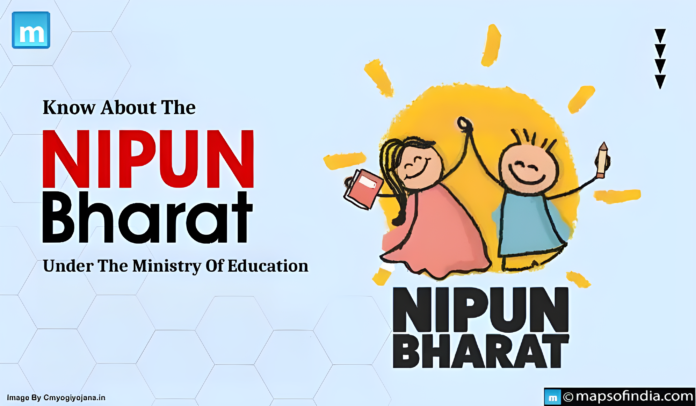The National Initiative for Proficiency in Reading with Understanding and Numeracy (NIPUN) Bharat Scheme was introduced by the Ministry of Education. It strives to meet the educational requirements of children between 3 and 9.
Key Facts
- This initiative is being introduced as a component of National Education Policy (NEP) 2020
- This strategy intends to open the door for fundamental changes in the nation’s K–12 and higher education institutions. The National Policy on Education (NPE), 1986, which lasted 34 years, was superseded by this policy.
Primary Goal
- By 2026–2027, every child will have attained the required learning abilities in reading, writing, and mathematics by the end of third grade by creating an environment that facilitates the universal acquisition of fundamental literacy and numeracy.
Focus Areas
- It will concentrate on giving children access to education and keeping them in school during their formative years, developing teachers’ capacities, creating high-quality, varied student and teacher resources/learning content, and monitoring each child’s progress in achieving learning objectives.
Implementation
- The Department of School Education and Literacy (DSEL) will carry out NIPUN Bharat’s execution.
- Under the auspices of the government-funded Samagra Shiksha plan, a five-tier implementation system will be established at the national, state, district, block, and school levels across all states and UTs.
- Rashtriya Madhyamik Shiksha Abhiyan (RMSA), Sarva Shiksha Abhiyan (SSA), and Teacher Education (TE) were merged into the “Samagra Shiksha” programme .
- The program aims to tackle schooling holistically, from nursery to Class XII.
Curriculum
- NCERT is creating a unique curriculum for foundational literacy and numeracy (FLN) as part of NISHTHA (National Initiative for School Heads and Teachers Holistic Advancement).
- In 2022, about 25 lakh teachers who teach in the pre-primary through primary grades will receive FLN training.
- NISHTHA is an initiative for “Improving Quality of Elementary Education through Integrated Teacher Training” to create capability.
- Stage-by-stage goals are defined on a continuum, starting with the pre-primary or balvatika classes.
Expected Results
- Foundational solid skills help children stay in school, lowering the dropout rate and improving the transition rate from fundamental to upper elementary and secondary stages.
- The quality of education will increase with activity-based learning and a positive learning environment.
- Learning will be made interesting and entertaining by utilizing cutting-edge pedagogies in the classroom, such as toy-based and interactive learning.
- Intensive capacity training for teachers would empower them and give them more freedom to select the methodology.
- A Holistic Progress Card will show the child’s progress across all their interconnected and interdependent developmental domains, such as physical and motor growth, socio-emotional advancement, literacy and numeracy improvement, cognitive development, and life skills, among others.
- Having children follow a steeper learning curve might benefit their future prospects and employment.
- Since practically every kid attends the early grades, focusing on them will also help the socioeconomically disadvantaged group, ensuring that they have access to an egalitarian and inclusive education.
Let’s briefly go over the constitutional provisions that deal with education
- State-funded, egalitarian, and accessible education is outlined in Articles 45 and 39 (f) of the Directive Principles of State Policy (DPSP) included in Part IV of the Indian Constitution.
- Education was shifted from the State to the Concurrent List by the 42nd Amendment to the Indian Constitution in 1976.
- State governments are supposed to follow the general direction provided by the federal government’s education programmes. However, it is optional; Tamil Nadu, for example, does not adhere to the 1968 first education policy’s three-language formula.
- Education became an absolute right under Article 21-A in 2002 with the 86th Amendment of the Indian Constitution.




